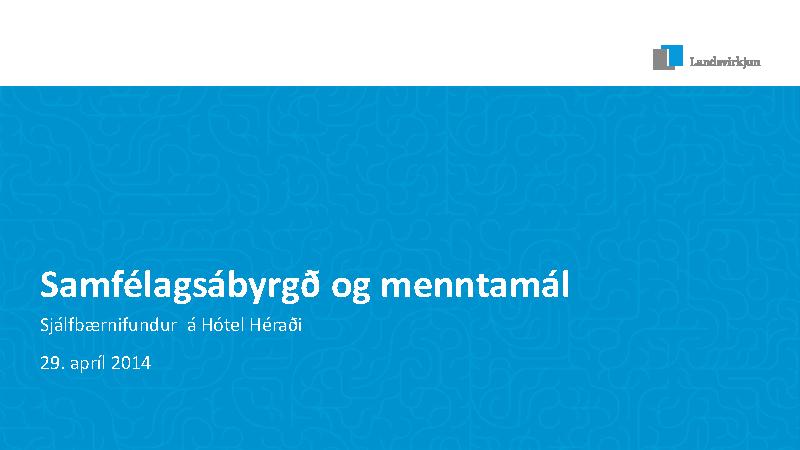Progress
Figure 1. Percentage of working hours employees at Alcoa Fjarðaál and Fljótsdalsstöð power station spend on work-related training (project effect: direct). Note 2020 was only the implementation of novice training at Alcoa and the training that could be carried out due to restrictions on gatherings and disease control measures.
Figure 2. Percentage of employees with primary education (ISCED 1.2) compared to employed persons in the Capital area and outside the Capital area. Note! All employees at Fljótsdalsstöð power station have education beyond primary education, and the measurement of 0% does not show in the picture.
Figure 3. Percentage of employees with upper secondary/post-secondary education (ISCED 3.4) compared to employed persons in the Capital area and outside of the Capital area
Figure 4. Percentage of employees with a university degree (ISCED 5.6) compared to employed persons in the Capital area and outside of the Capital area.
Updated: April 24, 2024
Source: Alcoa Fjarðaál (2009 -2024), Landsvirkjun (2009 - 2024), Statistic Iceland, retrieved May 12, 2020.
Metrics, Targets and Monitoring Protocol
What is measured?
- Percentage of working hours employees at Alcoa Fjarðaál and Fljótsdalsstöð power station spend on work-related training (project effect: direct).
- Education levels of employees at Fjarðaál and Fljótsdalsstöð power station compared to other employees in Iceland. Survey made every five years (project effect: indirect).
- Percentage with university degree (ISCED 5.6)
- Percentage with vocational or college education (ISCED 3.4)
- Percentage with basic education (ISCED 1.2)
Monitoring Protocol
- Data is collected annually.
- Landsvirkjun: The company operates a registering system which collects records on time invested in courses, but no vocational training is recorded. The manager of the power station will collect this information.
- Fjarðaál: Information from Human Resources database.
- Data collected every five years.
- Alcoa Fjarðaál HR team and Landsvirkjun Human Resources Department collect information every five years on the employees' education level. Statistics Iceland publishes information about educational level in Iceland every five years.
Targets
-
- Landsvirkjun: Target not applicable. Landsvirkjun will monitor and report data.
- Fjarðaál: Target not applicable. Fjarðaál will monitor and report data.
- Employee educational level equal or higher than in Iceland national education levels.
Possible countermeasures
Not applicable, monitoring only.
Updated: May 16, 2015 - Revised May 12, 2020
Changes of indicator
In annual general meeting May 6, 2015 a change in wording was approved.
| Orginal text | Changed text |
|---|---|
|
|
Rationale for changes: There is a mismatch between monitoring protocol and what is measured. The protocol refers to employees at Landsvirkjun but the results apply to employees at Fljótsdalsstöð power station only, since the project is about East Iceland.
This indicator was originally number 5.1. It was then named Alcoa and Landsvirkjun Employee Training and Education Levels and can be found under that number in documents of the project from 2005 and 2006.
The indicator number has been changed twice.
| Year | Nr. | Indicator name |
|---|---|---|
| 2020 | 4.1.1 | Education and training |
| 2007 | 1.4 | Employee Training and Education |
Baseline
| Alcoa Fjarðaál | Landsvirkjun | |
|---|---|---|
| Percentage of working hours spent on courses and training. | 7,1% | 11,5% |
| Education level | Capital area | Outside Capital area | ||
|---|---|---|---|---|
| Men | Women | Men | Women | |
| Primary Education (ISCED 1,2) | 14,6% | 20,3% | 23,9% | 29,2% |
| Occupational and further education (ISCED 3,4) | 21,6% | 16,3% | 22,7% | 11,0% |
| University degree (ISCED 5,6,7,8) | 12,6% | 13,8% | 5,6% | 7,2% |
| Information missing | 0,5% | 0,4% | 0,1% | 0,3% |
| Samtals: | 49,2% | 50,8% | 52,4% | 47,4% |
Rationale for Indicator Selection
Increasing the education and training levels of a workforce provides the local economy with the potential for increased productivity and economic development. Alcoa and Landsvirkjun have the opportunity to invest in their employees through a comprehensive training program. Educated, trained employees can command higher salaries and, hence, employees' families can enjoy a higher standard of living.
From phase I/II report on indicators and baseline from April 2005
Further reading

Samfélagsábyrgð og menntamál
Kynning Berglindar Ránar Ólafsdóttur á ársfundi Sjálfbærniverkefnisins 2014
